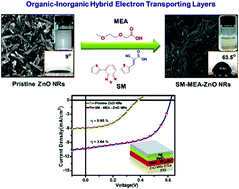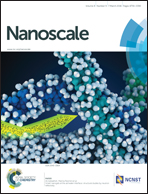Co-functionalized organic/inorganic hybrid ZnO nanorods as electron transporting layers for inverted organic solar cells†
Abstract
In an unprecedented attempt, we present an interesting approach of coupling solution processed ZnO planar nanorods (NRs) by an organic small molecule (SM) with a strong electron withdrawing cyano moiety and the carboxylic group as binding sites by a facile co-functionalization approach. Direct functionalization by SMs (SM-ZnO NRs) leads to higher aggregation owing to the weaker solubility of SMs in solutions of ZnO NRs dispersed in chlorobenzene (CB). A prior addition of organic 2-(2-methoxyethoxy)acetic acid (MEA) over ZnO NRs not only inhibits aggregation of SMs over ZnO NRs, but also provides enough sites for the SM to strongly couple with the ZnO NRs to yield transparent SM-MEA-ZnO NRs hybrids that exhibited excellent capability as electron transporting layers (ETLs) in inverted organic solar cells (iOSCs) of P3HT:PC60BM bulk-heterojunction (BHJ) photoactive layers. A strongly coupled SM-MEA-ZnO NR hybrid reduces the series resistance by enhancing the interfacial area and tunes the energy level alignment at the interface between the (indium-doped tin oxide, ITO) cathode and BHJ photoactive layers. A significant enhancement in power conversion efficiency (PCE) was achieved for iOSCs comprising ETLs of SM-MEA-ZnO NRs (3.64%) advancing from 0.9% for pristine ZnO NRs, while the iOSCs of aggregated SM-ZnO NRs ETL exhibited a much lower PCE of 2.6%, thus demonstrating the potential of the co-functionalization approach. The superiority of the co-functionalized SM-MEA-ZnO NRs ETL is also evident from the highest PCE of 7.38% obtained for the iOSCs comprising BHJ of PTB7-Th:PC60BM compared with extremely poor 0.05% for non-functionalized ZnO NRs.


 Please wait while we load your content...
Please wait while we load your content...